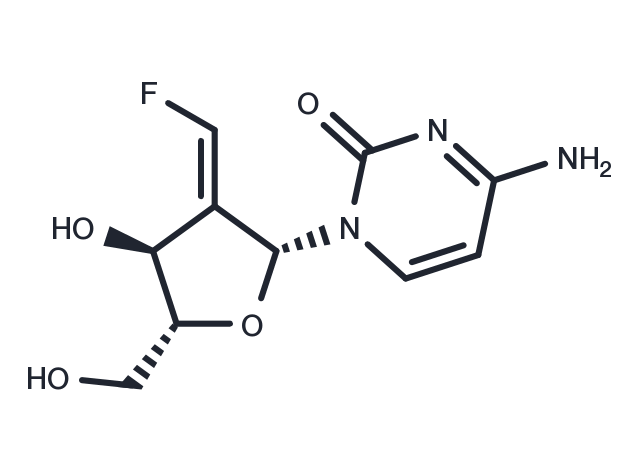Powder: -20°C for 3 years | In solvent: -80°C for 1 year


Tezacitabine is a cytostatic and cytotoxic antimetabolite. Tezacitabine is a nucleoside analogue characterized by a dual mechanism of action. Tezacitabine irreversibly inhibits ribonucleotide reductase and can be incorporated into DNA during replication or repair, resulting in DNA chain termination. Tezacitabine blocks tumor cells in G1 and S phases of the cell cycle and induces apoptotic cell death. Tezacitabine has the potential to treat leukemia and solid tumors[1][2].

| Pack Size | Availability | Price/USD | Quantity |
|---|---|---|---|
| 10 mg | 6-8 weeks | $ 1,280.00 | |
| 25 mg | 6-8 weeks | $ 2,550.00 |
| Description | Tezacitabine is a cytostatic and cytotoxic antimetabolite. Tezacitabine is a nucleoside analogue characterized by a dual mechanism of action. Tezacitabine irreversibly inhibits ribonucleotide reductase and can be incorporated into DNA during replication or repair, resulting in DNA chain termination. Tezacitabine blocks tumor cells in G1 and S phases of the cell cycle and induces apoptotic cell death. Tezacitabine has the potential to treat leukemia and solid tumors[1][2]. |
| In vitro | Tezacitabine (0.01-10 μM; 24 hours; CCRF-SB, KG-1, Jurkat, COLO-205, MCF-7 and PC-3 cells) treatment leads to the G1 and S-phase leaky block of the cell cycle [1]. Tezacitabine (0.01-10 μM; 24 hours; CCRF-SB, KG-1, Jurkat, COLO-205, MCF-7 and PC-3 cells) treatment concentration-dependently apoptosis the cells by the caspase 3/7 pathway[1]. Tezacitabine has highly cytostatic and cytotoxic properties. The cytotoxic effect of tezacitabine is manifested not only in apoptosis but also in changes in protein metabolism[1]. Cell Cycle Analysis [1] Cell Line: CCRF-SB, KG-1, Jurkat, COLO-205, MCF-7 and PC-3 cells Concentration: 0.01 μM, 0.1 μM, 1.0 μM, and 10 μM Incubation Time: 24 hours Result: Induced leaky block of the G1 (at concentrations higher than 10 nM) and S-phase (at low concentration) of the cell cycle. Apoptosis Analysis [1] Cell Line: CCRF-SB, KG-1, Jurkat, COLO-205, MCF-7 and PC-3 cells Concentration: 0.01 μM, 0.1 μM, 1.0 μM, and 10 μM Incubation Time: 24 hours Result: Concentration-dependently induced apoptotic death of cells by the caspase 3/7 pathway. |
| In vivo | Tezacitabine (100 mg/kg; intraperitoneal injection; daily; female nude mice) treatment inhibits the growth of tumors in HCT 116 tumor xenografts [2]. Animal Model: Female nude mice (7-9-week-old) injected with HCT 116 cells [2] Dosage: 100 mg/kg Administration: Intraperitoneal injection; daily; 14 days Result: Tumor growth in HCT 116 tumor xenografts is inhibited. |
| Molecular Weight | 257.22 |
| Formula | C10H12FN3O4 |
| CAS No. | 130306-02-4 |
Powder: -20°C for 3 years | In solvent: -80°C for 1 year
You can also refer to dose conversion for different animals. More
bottom
Please see Inhibitor Handling Instructions for more frequently ask questions. Topics include: how to prepare stock solutions, how to store products, and cautions on cell-based assays & animal experiments, etc.
Tezacitabine 130306-02-4 inhibitor inhibit
